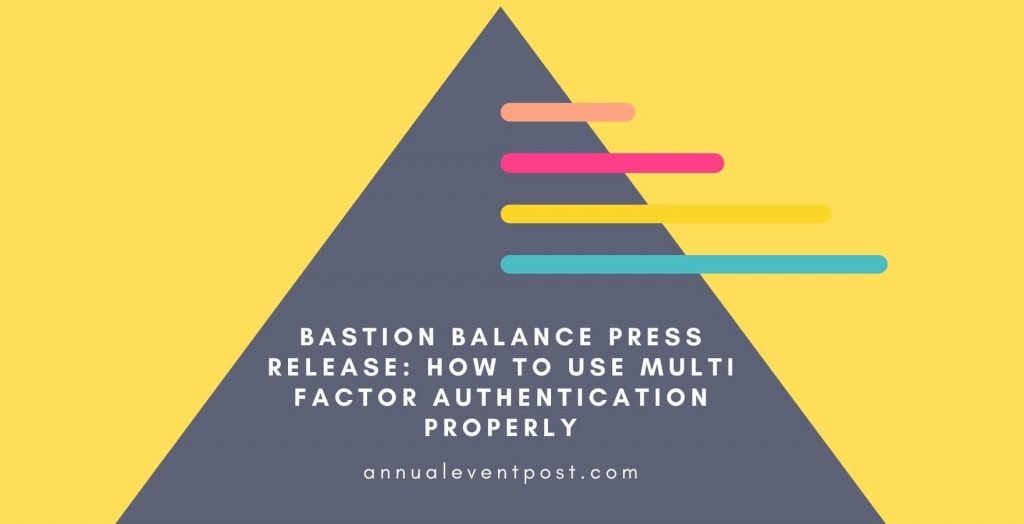
Global wealth management firm, Bastion Balance, has released a cybersecurity alert from their head offices in Seoul, Korea. In a response to a recent increase in online phishing, fraud, and scam activity Bastion Balance head of cybersecurity recommends the use of multi-factor authentication (MFA) across all platforms. Existing users of MFA should ensure they have implemented it correctly.
MFA works by requiring two or more types of identity credentials to gain access to online or offline databases, software, and applications. User logins could comprise a combination of a security pin code, security question, a physical token, an authenticator application like LastPass, email verification, SMS code verification, biometrics, or fingerprint identification.
The advantage of using MFA is that it provides greater protection against illegal attempts to gain unauthorized access to online accounts. Because even if a cybercriminal manages to steal one form of authentication, with MFA in place they will still need to acquire another form of credential to access accounts.
It’s possible to activate MFA across a range of devices, applications, and web browsers. The initialization process can vary slightly depending on the program or device used. Generally, mobile device MFA security is set up in the user profile.
Some of the most commonly used applications and software accounts that offer multi-factor or two-factor authentication include Apple desktop computers and mobile devices, Microsoft accounts, web browsers like Yahoo!, and messaging apps like WhatsApp.
With many more businesses using social media for promotional or marketing purposes, as well as for online stores, it’s important to activate MFA for social media accounts like Facebook, Linkedin, Instagram, Twitter.
Here is a quick overview of some of the easy ways to install MFA across your systems:
Apple ID
For most Apple products two-factor authentication is switched on in the security tab of the iCloud Account Details section in the System Preferences. The latest Apple hardware is often protected with MFA by default. In this case, if you want to install an update you may need to turn it off first, then turn it back on after the update has been installed.
It’s possible to set up two-factor authentication for Facebook in the settings, by selecting the security and login button. Scroll to the tab for two-factor authentication, then click on edit. Use the on-screen instructions to set up the authentication method of your choice – either SMS codes sent to your mobile phone, or login code from a separate authentication app like LastPass, or Google Authenticator.
With MFA set up, Facebook will request a special login code for access when logging in from a new or different mobile device or computer. Alerts will also be sent by Facebook any time it detects another user trying to log in to the account.
Facebook Messenger
Two-factor authentication for Facebook Messenger works by requesting a unique code whenever you attempt to access it from an unknown device. Alerts will also be sent by Facebook any time it detects another user trying to log in to the account.
Gmail
Two-factor authentication for Gmail is available through your Google Account, via the security option. The second verification step can be a phone prompt, a 6-digit code sent via SMS or a security key device.
LinkedIn two-factor authentication works by sending a verification code to a registered mobile phone every time a new unknown device signs in to LinkedIn.
Once two-factor authentication is activated in Instagram, a unique login code will be required to confirm the login from an unrecognized computer or mobile device. Alerts will also be sent by Instagram any time it detects another user trying to log in to the account.
Microsoft Accounts
With MFA set up in your Microsoft Account, a security code will be sent to your email, mobile phone, or authenticator app when sign-in occurs on an unknown device.
Set up two-factor identification for your Twitter account through the login verification option in the security menu. Twitter will send a security code to your mobile phone when logging in to your account.
WhatsApp and WhatsApp Business
Once two-factor authentication is activated for WhatsApp or WhatsApp Business, a unique login code will be required to confirm the login from an unrecognized computer or mobile device. Alerts will also be sent by WhatsApp any time it detects another user trying to log in to the account.
Yahoo!
You can enable two-step verification for your Yahoo! account via a secondary text message or phone call, as selected by the user. This will come into use when login is attempted from a new or unknown device or web browser.
Note: Bastion Balance is a leader in asset management, wealth management, portfolio management, and estate planning services. They would like to remind their clients to never share multifactor authentication credentials online, via phone, or in person.
Brade Pro has a strong background in generating interesting content that gives a blog, website, or business true value. He is a technology geek and loves to talk about tech.